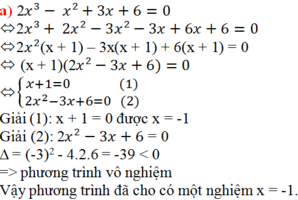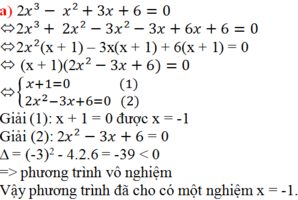
Hãy nhập câu hỏi của bạn vào đây, nếu là tài khoản VIP, bạn sẽ được ưu tiên trả lời.




b) x.(x+1). ( x+ 4). (x+ 5) = 12
⇔ [ x. (x + 5)]. [(x+1). (x+ 4)] = 12
⇔ x 2 + 5 x ⋅ x 2 + 4 x + x + 4 − 12 = 0 ⇔ x 2 + 5 x ⋅ x 2 + 5 x + 4 − 12 = 0 ( * )
Đặt t = x 2 + 5 x + 2
= > x 2 + 5 x = t – 2 v à x 2 + 5 x + 4 = t + 2
Khi đó phương trình (*) trở thành:
( t – 2). (t+ 2) - 12 = 0
⇔ t 2 − 4 − 12 = 0 ⇔ t 2 − 16 = 0 ⇔ t 2 = 16 ⇔ t = ± 4
+ Với t = 4 ta có: x 2 + 5 x + 2 = 4
⇔ x 2 + 5 x – 2 = 0 ( * * )
Có a= 1, b = 5, c = - 2 và ∆ = 5 2 – 4 . 1 . ( - 2 ) = 33 > 0
Nên (**) có 2 nghiệm phân biệt là:

* Với t = - 4 ta có: x 2 + 5 x + 2 = - 4
⇔ x 2 + 5 x + 6 = 0 ( * * * )
Có a= 1, b = 5, c= 6 và ∆ = 5 2 – 4 . 1 . 6 = 1 > 0
Phương trình (***) có 2 nghiệm là:

Vậy tập nghiệm của phương trình đã cho là:



b) x.(x+1). ( x+ 4). (x+ 5) = 12
⇔ [ x. (x + 5)]. [(x+1). (x+ 4)] = 12
⇔ x 2 + 5 x ⋅ x 2 + 4 x + x + 4 − 12 = 0 ⇔ x 2 + 5 x ⋅ x 2 + 5 x + 4 − 12 = 0 ( * )
Đặt t = x 2 + 5 x + 2
= > x 2 + 5 x = t – 2 v à x 2 + 5 x + 4 = t + 2
Khi đó phương trình (*) trở thành:
( t – 2). (t+ 2) - 12 = 0
⇔ t 2 - 4 - 12 = 0 ⇔ t 2 - 16 = 0 ⇔ t 2 = 16 ⇔ t = ± 4
+ Với t = 4 ta có: x 2 + 5 x + 2 = 4
⇔ x2 +5x – 2 = 0 (**)
Có a= 1, b = 5, c = - 2 và ∆ = 5 2 – 4 . 1 . ( - 2 ) = 33 > 0
Nên (**) có 2 nghiệm phân biệt là:

* Với t = - 4 ta có: x 2 + 5 x + 2 = - 4
⇔ x 2 + 5 x + 6 = 0 ( * * * )
Có a= 1, b = 5, c= 6 và ∆ = 5 2 – 4 . 1 . 6 = 1 > 0
Phương trình (***) có 2 nghiệm là:

Vậy tập nghiệm của phương trình đã cho là:



`1)(x+2)(x+3)(x-7)(x-8)=144`
`<=>[(x+2)(x-7)][(x+3)(x-8)]=144`
`<=>(x^2-5x-14)(x^2-5x-24)=144`
`<=>(x^2-5x-19)^2-25=144`
`<=>(x^2-5x-19)^2-169=0`
`<=>(x^2-5x-6)(x^2-5x-32)=0`
`+)x^2-5x-6=0`
`<=>` $\left[ \begin{array}{l}x=6\\x=-1\end{array} \right.$
`+)x^2-5x-32=0`
`<=>` $\left[ \begin{array}{l}x=\dfrac{5+3\sqrt{17}}{2}\\x=\dfrac{5-3\sqrt{17}}{2}\end{array} \right.$
Vậy `S={-1,6,\frac{5+3\sqrt{17}}{2},\frac{5-3\sqrt{17}}{2}}`
1: Ta có: \(\left(x+2\right)\left(x+3\right)\left(x-7\right)\left(x-8\right)=144\)
\(\Leftrightarrow\left(x^2-7x+2x-14\right)\left(x^2-8x+3x-24\right)=144\)
\(\Leftrightarrow\left(x^2-5x-14\right)\left(x^2-5x-24\right)-144=0\)
\(\Leftrightarrow\left(x^2-5x\right)^2-38\left(x^2-5x\right)+336-144=0\)
\(\Leftrightarrow\left(x^2-5x\right)^2-38\left(x^2-5x\right)+192=0\)
\(\Leftrightarrow\left(x^2-5x\right)^2-6\left(x^2-5x\right)-32\left(x^2-5x\right)+192=0\)
\(\Leftrightarrow\left(x^2-5x\right)\left(x^2-5x-6\right)-32\left(x^2-5x-6\right)=0\)
\(\Leftrightarrow\left(x^2-5x-6\right)\left(x^2-5x-32\right)=0\)
\(\Leftrightarrow\left(x-6\right)\left(x+1\right)\left(x^2-5x-32\right)=0\)
\(\Leftrightarrow\left[{}\begin{matrix}x-6=0\\x+1=0\\x^2-5x-32=0\end{matrix}\right.\Leftrightarrow\left[{}\begin{matrix}x=6\\x=-1\\x=\dfrac{5-3\sqrt{17}}{2}\\x=\dfrac{5+3\sqrt{17}}{2}\end{matrix}\right.\)
Vậy: \(S=\left\{6;-1;\dfrac{5-3\sqrt{17}}{2};\dfrac{5+3\sqrt{17}}{2}\right\}\)

1.
ĐKXĐ: \(x< 5\)
\(\Leftrightarrow\sqrt{\dfrac{42}{5-x}}-3+\sqrt{\dfrac{60}{7-x}}-3=0\)
\(\Leftrightarrow\dfrac{\dfrac{42}{5-x}-9}{\sqrt{\dfrac{42}{5-x}}+3}+\dfrac{\dfrac{60}{7-x}-9}{\sqrt{\dfrac{60}{7-x}}+3}=0\)
\(\Leftrightarrow\dfrac{9x-3}{\left(5-x\right)\left(\sqrt{\dfrac{42}{5-x}}+3\right)}+\dfrac{9x-3}{\left(7-x\right)\left(\sqrt{\dfrac{60}{7-x}}+3\right)}=0\)
\(\Leftrightarrow\left(9x-3\right)\left(\dfrac{1}{\left(5-x\right)\left(\sqrt{\dfrac{42}{5-x}}+3\right)}+\dfrac{1}{\left(7-x\right)\left(\sqrt{\dfrac{60}{7-x}}+3\right)}\right)=0\)
\(\Leftrightarrow x=\dfrac{1}{3}\)
b.
ĐKXĐ: \(x\ge2\)
\(\sqrt{\left(x-2\right)\left(x-1\right)}+\sqrt{x+3}=\sqrt{x-2}+\sqrt{\left(x-1\right)\left(x+3\right)}\)
\(\Leftrightarrow\sqrt{\left(x-2\right)\left(x-1\right)}-\sqrt{x-2}+\sqrt{x+3}-\sqrt{\left(x-1\right)\left(x+3\right)}=0\)
\(\Leftrightarrow\sqrt{x-2}\left(\sqrt{x-1}-1\right)-\sqrt{x+3}\left(\sqrt{x-1}-1\right)=0\)
\(\Leftrightarrow\left(\sqrt{x-1}-1\right)\left(\sqrt{x-2}-\sqrt{x+3}\right)=0\)
\(\Leftrightarrow\left[{}\begin{matrix}\sqrt{x-1}-1=0\\\sqrt{x-2}-\sqrt{x+3}=0\end{matrix}\right.\)
\(\Leftrightarrow\left[{}\begin{matrix}x-1=1\\x-2=x+3\left(vn\right)\end{matrix}\right.\)
\(\Rightarrow x=2\)


Xét x=0 ==> loại
Xét x\(\ne\)0,ta chia cả 2 vế cho x2 thu được:
4(x2+17x+60)(x2+16x+60)=3x2
4(x+\(\frac{60}{x}\)+17)(x+\(\frac{60}{x}\)+16)=3
Đặt x+\(\frac{60}{x}\)+16=t,ta được
4(t+1).t=3 <=> 4t2+4t-3=0 <=> t=\(\frac{1}{2}\)hoặc t=\(\frac{-3}{2}\)
Với t=1/2,ta có x+\(\frac{60}{x}\)+16=1/2 <=> x=-15/2 hoặc x=-8
Với t=-3/2,ta có x+\(\frac{60}{x}\)+16=-3/2 <=> ... bạn tự giải nốt nhé.